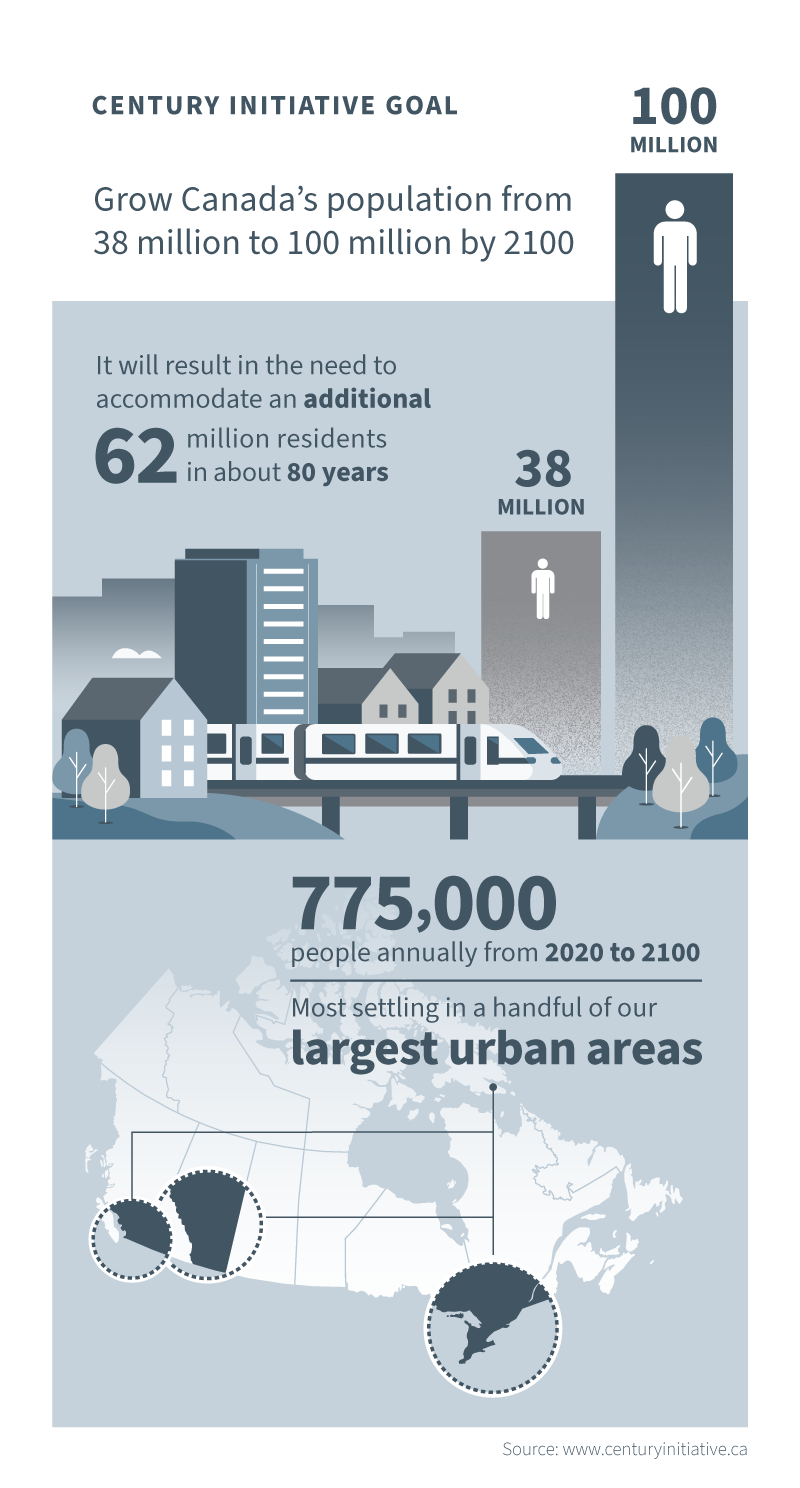The right approach to Canada’s population and cities opportunities
Canada’s population is growing fast – and over the course of this century, it will grow to be as large or larger than other G7 nations.Century Initiative, is focused on responsibly growing Canada’s population from 38 million to 100 million by 2100. While this may seem like a particularly ambitious level of growth, there is a wide consensus among economists that large increases are critical to maintaining and continuing to enhance Canada’s standard of living. There are opportunities that come with scaling Canada.
舱口已与一些最专业的合作gressive cities and developers on urban development projects that benefit people and the environment, while enhancing profits for investors. Planning and development practices are critical to successfully accommodating people without straining the environment and making better use of infrastructure. Achieving the Century Initiative’s goal would involve accommodating an additional 62 million residents in about 80 years, or 775,000 people annually from 2020 to 2100. For any small to mid-sized country like Canada, these are huge numbers. |

These new residents need homes, jobs, education, services, and amenities. Mixed-use, people-oriented communities that support the residential, commercial, health and education, and cultural needs of residents will be essential. Industrial facilities that facilitate economic production and movement of goods are required too. Optimal execution will result in economic, social, and environmental outcomes that benefit all. Some progressive urban planning, particularly in Canada’s largest cities in the past two decades, has helped pave the way for a better future with respect to reduced urban sprawl. However far more needs to be done, and some actions have increased the risk of worsening outcomes.
We need to aggressively take action to avoid traditional planning outcomes of intensive urban growth in infrastructure, including longer commutes, more traffic congestion, more carbon emissions, loss of natural habitats and greenspace, and lower quality of life.
展望未来,城市设计和规划,真正的izes a step change in active transportation (walking, bicycling), shorter daily trips, and public transit ridership compared to traditional urban (and suburban) growth in Canada is crucial to meeting huge and unmet demand for housing while decreasing emissions. In 2019, Canada’s biggest contributors to greenhouse gas emissions were buildings (including housing), industry, and transportation. Housing and the way our cities function largely drives the greenhouse footprints of buildings and transportation. Transportation drives housing access. Both transportation and housing create the conditions for labour to come together and be productive in business formation and growth. If communities are developed, retrofitted, and intensified in efficient ways, we can better achieve desperately needed, significant carbon savings and realize accelerated provision of housing. New and retrofitted transportation infrastructure can create opportunities for housing and workplaces that promote low-carbon mobility and buildings.

To support growth in optimal ways, Canadians do not need advanced technology or completely new ways of building. The vision for a sustainable and prosperous future can be realized by applying existing scientific- and evidence-based best practices to achieve steady improvement and innovation. Technological innovation will help, but we do not need – nor can we afford to wait – especially because we already have the knowledge and means to produce significant improvements and value creation. As planners, economists, architects, and engineers, we have helped numerous clients envision, plan, and execute projects, advise on feasibility options, and collaborate with communities to develop successful outcomes.
Addressing housing pressures and economic change
Hatch has a remarkable track record of experience and expertise to help vision, plan, and implement transit-oriented community (TOC) development, where public and private sector actors work together to sustainably cater to populations and economies. TOC encourages active and public transportation and concentrates development around public transportation nodes or corridors. TOC projects can accommodate growth, avoid sprawl, and preserve natural environments so people can lead healthier, emission-free lives at home, work, or play, reducing the whole life-cycle costs to people, businesses, and planet. We can also create more productive, interesting, and equitable communities.
Design excellence, including better outcomes of all kinds, can be achieved by taking the right approach. Hatch’s “Great Places Process” has been applied to community development projects around the world with great success. The results speak for themselves: places that are more livable, more lovable, and more productive, generating higher value for investors, residents and visitors. They are more resilient too.
支持经济增长最优,我们可以用正确的investments to boost productivity and great outcomes for our communities. As planners, economists, architects, and engineers, it is our job to be involved from the start of a project, advise on feasibility and optimization of options, and collaborate with communities to develop successful, best-possible outcomes. Hatch has the expertise to assist TOCs, in which public and private sectors work together to sustainably cater to growing populations and economies.
In coming blogs, we will address transit expansion in Ontario, aggressive TOC sustainability, how to bring together all the moving parts of urban development, and how to address challenges and opportunities to create a more prosperous and equitable world.
Stay tuned!
Other blogs by this author

Michael Sutherland
Director, Urban Solutions
With remarkable experience launching large city-building projects with both the public and private sectors, Michael is a master strategist, helping teams realize the identification, planning, negotiation and execution of urban projects which enable attractive, valuable, sustainable development. He is a proven practitioner in making great transportation and urban development projects happen.



